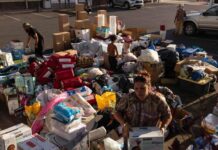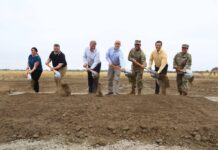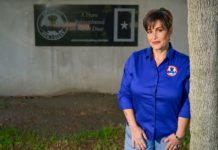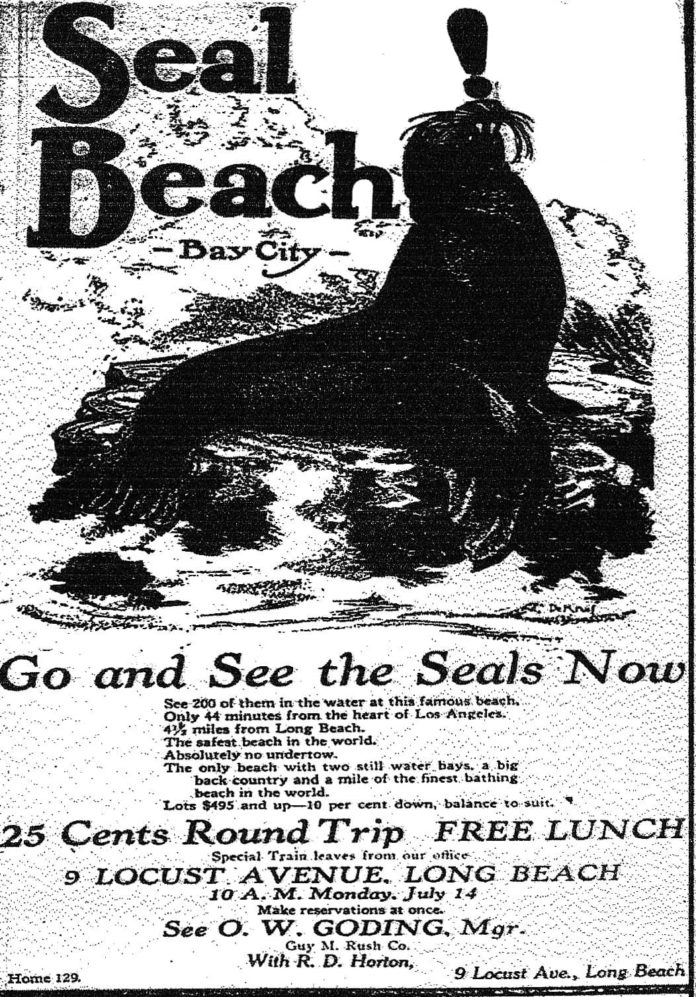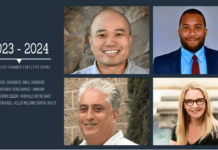JULY 17, 1913 – 2,000 people showed up on the beaches of Bay City yesterday (July 17, 1913) as the subdivision was officially rechristened Seal Beach by the town’s new real estate agent and ultra community booster, the Guy M. Rush Real Estate Company. The July 18th, 1913 LA Times reported that the Bayside Land Company made sure “the tables were piled high with heaps of barbecued beef, tubs filled with frijoles, buns, pickles, and other toothables and barrels of coffee.” After a couple hours of feasting, the occasion was graced by a speech from “Mayor Rose” who had been elected Mayor by the few residents of the unincorporated community. Bayside Land Company owner P.A. Stanton lauded Mayor Rose who would lead a town that would be “chemically pure.” After the speeches, the officials led a “grand march to dedicate the new dance pavilion which has a fine maple floor and when finished will be one of the finest dance pavilions on the coats.” Nearly everyone took part in the grand march to the music of an orchestra.
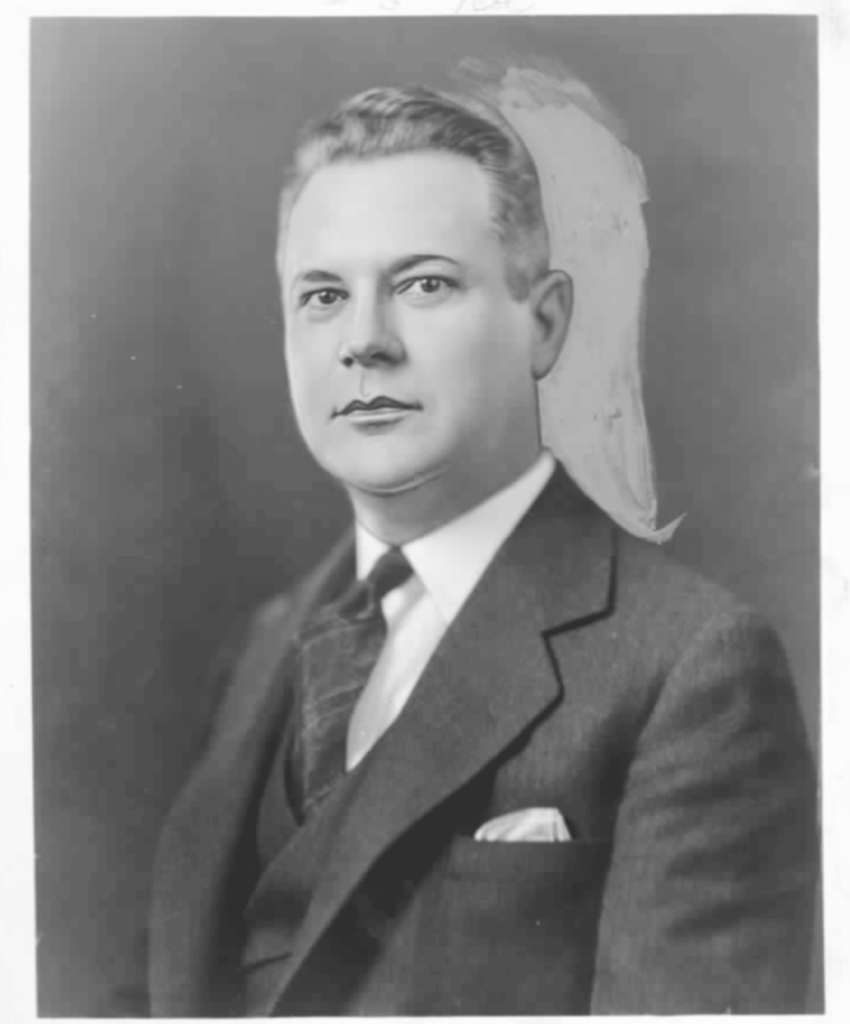
As a little background, the Guy M. Rush Company was one of the top real estate firms in Los Angeles at the time — calling themselves “Southern California’s real estate experts.” For whatever reasons, they decided to take on the failed real estate subdivision known as Bay City. Formed in 1904 by the Bayside Land Company on the high piece of land between Alamitos Bay and Anaheim Bay, the subdivision failed to attract attention against other growing beach resorts like Long Beach, Hermosa Beach, Venice and Santa Monica. The Financial Crisis of 1907 didn’t help either, nor did the 1906 San Francisco Earthquake which sucked all the investment money out of Southern California to more lucrative rebuilding loans to the north.
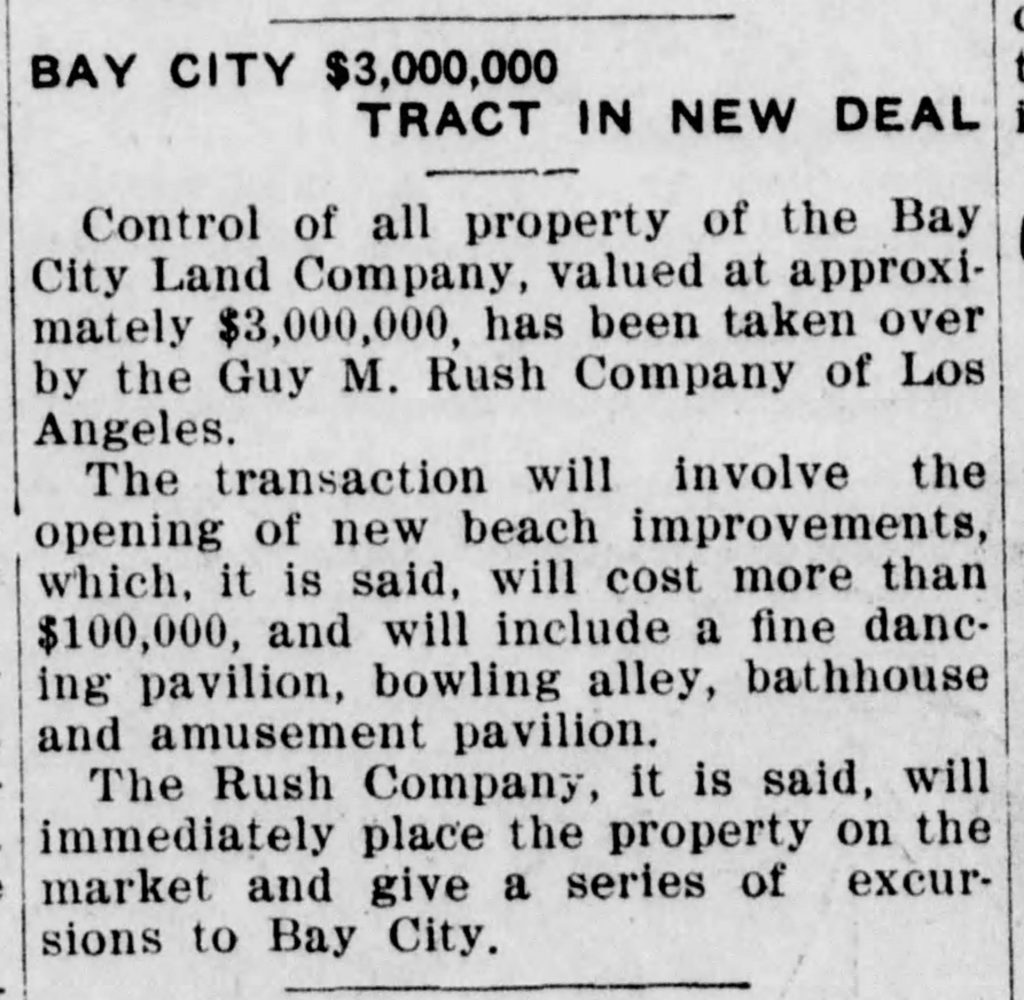 Anyway, in Spring 1913 the Rush Company optioned the property from the Bayside Land Company and although it wasn’t officially announced until July 2), they were making significant changes as early as April of that year. They purchased 20 acres at Anaheim Landing from the Hellman Ranch company, and then laid out streets (13th through 17th, and Marine and Dolphin — all the narrower streets), donated the land for the new Bay City School (the Zoeter site, located in the often rain-flooded lands between 10th and 12th. They also worked with the Pacific Electric Railway to introduce a new electric line running from the Long Beach Peninsula over a rail-only bridge at the inlet to Alamitos Bay, then along Ocean and up Main to a junction with the main line on Electric. The Rush organization also spent over $100,000 on the construction of two magnificent pavilions patterned after Atlantic City’s famed Steel Pier (the new pavilions flanked the improved pier, and it rebranded the failed resort of Bay City as “Seal Beach.”
Anyway, in Spring 1913 the Rush Company optioned the property from the Bayside Land Company and although it wasn’t officially announced until July 2), they were making significant changes as early as April of that year. They purchased 20 acres at Anaheim Landing from the Hellman Ranch company, and then laid out streets (13th through 17th, and Marine and Dolphin — all the narrower streets), donated the land for the new Bay City School (the Zoeter site, located in the often rain-flooded lands between 10th and 12th. They also worked with the Pacific Electric Railway to introduce a new electric line running from the Long Beach Peninsula over a rail-only bridge at the inlet to Alamitos Bay, then along Ocean and up Main to a junction with the main line on Electric. The Rush organization also spent over $100,000 on the construction of two magnificent pavilions patterned after Atlantic City’s famed Steel Pier (the new pavilions flanked the improved pier, and it rebranded the failed resort of Bay City as “Seal Beach.”
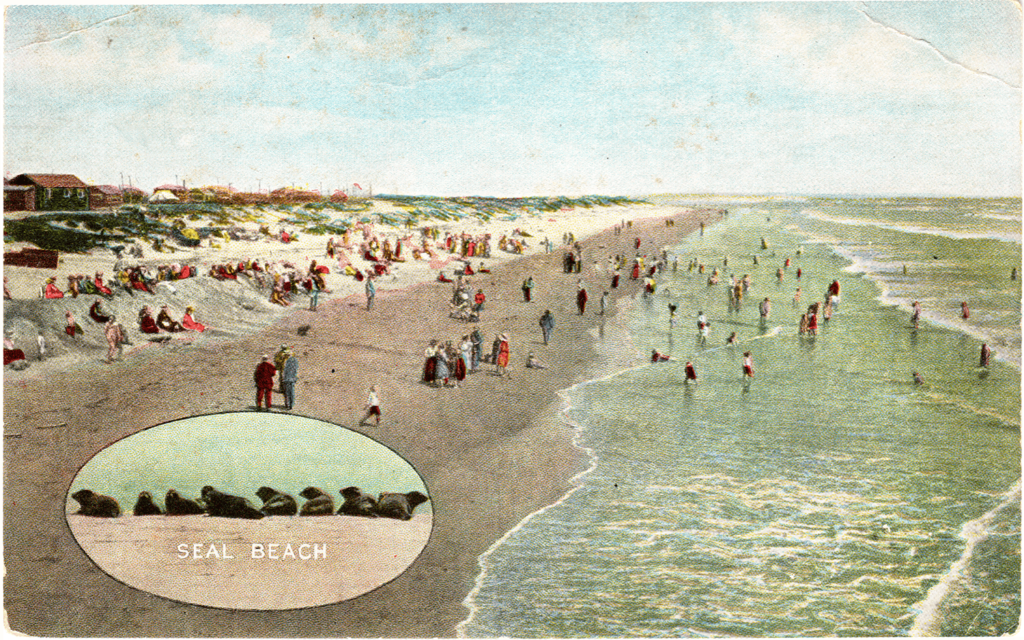 The marketing blitz included a nationwide marketing campaign of post cards and newspaper articles, with bad “trick photography” inserting seals almost everywhere. They also commissioned the many “Seal ads” drawn by Henry deKruif that were featured over the next year in Southern California newspapers. [Longtime Long Beach Librarian Claudine Burnett has written a very informative article on Rush’s 18-month “Seal” campaign, but she does get some things confused – among them, Rush and his company had no involvement with the Jewel City/Joy Zone campaign of 1916 which came after Rush walked away from Seal Beach and the Bayside Land Company turned to amusement operator Frank Burt to oversee construction of a roller coast and other concessions from the 1915 San Francisco Pan-Pacific Exposition.
The marketing blitz included a nationwide marketing campaign of post cards and newspaper articles, with bad “trick photography” inserting seals almost everywhere. They also commissioned the many “Seal ads” drawn by Henry deKruif that were featured over the next year in Southern California newspapers. [Longtime Long Beach Librarian Claudine Burnett has written a very informative article on Rush’s 18-month “Seal” campaign, but she does get some things confused – among them, Rush and his company had no involvement with the Jewel City/Joy Zone campaign of 1916 which came after Rush walked away from Seal Beach and the Bayside Land Company turned to amusement operator Frank Burt to oversee construction of a roller coast and other concessions from the 1915 San Francisco Pan-Pacific Exposition.
Burt oversaw some interesting July 17 activities himself. In 1917, the Joy Zone held the first bathing beauty contest in Orange County. (Venice beat them to the punch by a couple years.) Some of the contestants were locals but most were aspiring starlets who were urged by their movie studios to participate as a way of marketing the studio’s films.

What else happened on July 17? Well, it was certainly a busy day for Seal Beach history.
As some may be aware, metal and rubber embargos imposed during World War I, the Spanish Flu, and Prohibition provided a real financial punch in the gut to amusement resorts, but local rumrunners decided to take advantage of their seaside positions to import the illegal hooch. Big mother ships running from Canada to Mexico, made stops usually near the Cortes and Tanner banks about a hundred miles offshore of San Diego. Large boats would quickly transfer sacks of hooch onto larger motorboats and head towards a rendezvous point just beyond the US boundary limits off the Channel Islands. There it was transferred to amller, but numerous, very fast speedboats (faster than the US officials boats) which transported the precious cargo to many SoCal inlets. Among the most heavily trafficked were Anaheim Bay and Alamitos Bay and many Seal Beach residents were involved in the hooch transportation biz — so much so that Federal “Dry Officials” often cited Seal Beach as “Southern California’s wettest spot.”
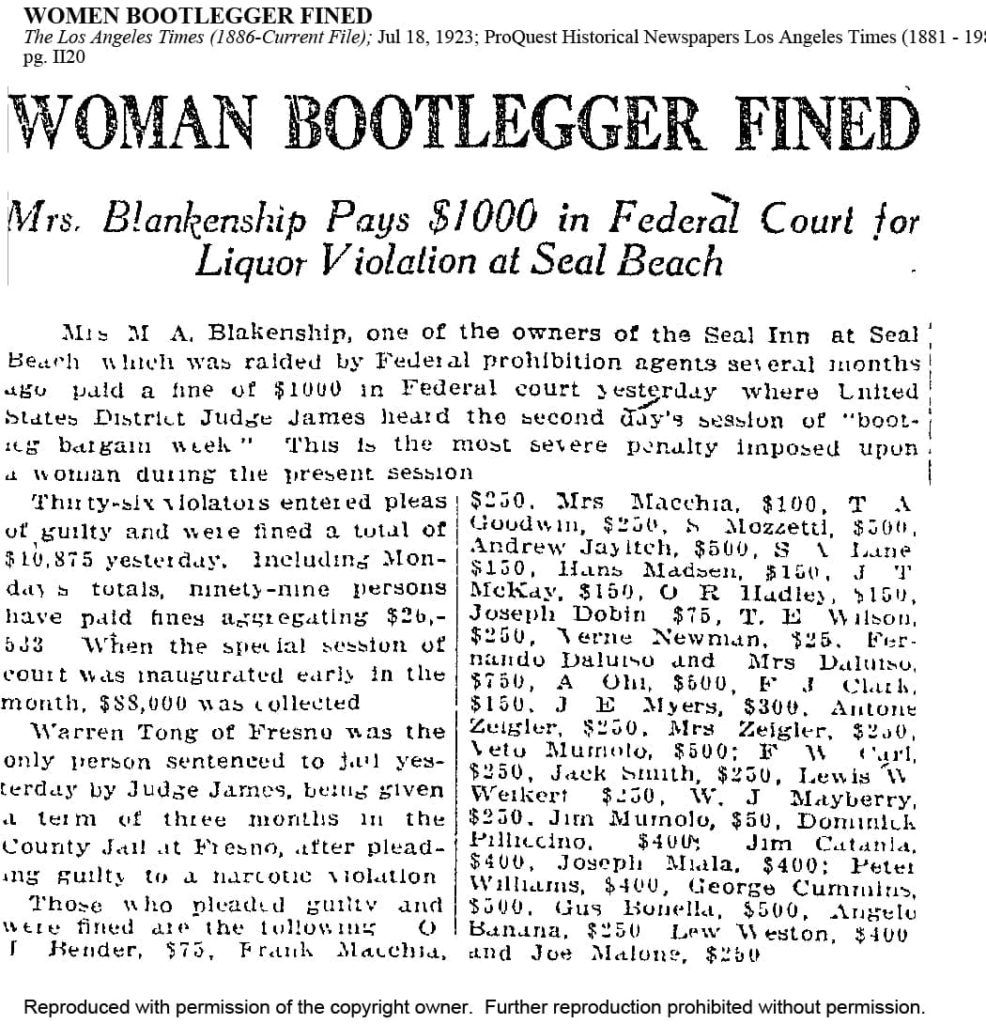 One of the local participants was Mildred Blankenship, owner of the Seal Hotel at Central Main (where the Hennessey’s parking lot is now.) Mildred came to Seal Beach around 1917 with her husband, Ferdinand C. Blankenship. Back in Salt Lake City, F.C. had interest in a couple taverns and a hotel and had more then run-in with the law for selling illegal liquor and “operating a disorderly house.” In Seal Beach, he soon bought interest in a couple hotels, the jewel Cafe and the Tower Cafe — and again had run-ins with the law. When he died in early 1923 of lingering influenza, Mildred took over his operations. Bootlegging was very very good to Mildred as was other forms of sin as Ms. Blankenship was also known as the town’s madam. She oversaw the horizontal operations at the Tourist hotel at 123 Main Street, the Seal Inn and across the street on the second floor of what is now Walt’s Wharf. By late 1923 she became one the town’s wealthier residents and larger landlords, and purchased with cash three of the four corners at Main and Central as well as all four corners of 8th and Central. In 1929 she sold the land where City Hall is now located, and the sold the land for the adjacent fire station and church as well.
One of the local participants was Mildred Blankenship, owner of the Seal Hotel at Central Main (where the Hennessey’s parking lot is now.) Mildred came to Seal Beach around 1917 with her husband, Ferdinand C. Blankenship. Back in Salt Lake City, F.C. had interest in a couple taverns and a hotel and had more then run-in with the law for selling illegal liquor and “operating a disorderly house.” In Seal Beach, he soon bought interest in a couple hotels, the jewel Cafe and the Tower Cafe — and again had run-ins with the law. When he died in early 1923 of lingering influenza, Mildred took over his operations. Bootlegging was very very good to Mildred as was other forms of sin as Ms. Blankenship was also known as the town’s madam. She oversaw the horizontal operations at the Tourist hotel at 123 Main Street, the Seal Inn and across the street on the second floor of what is now Walt’s Wharf. By late 1923 she became one the town’s wealthier residents and larger landlords, and purchased with cash three of the four corners at Main and Central as well as all four corners of 8th and Central. In 1929 she sold the land where City Hall is now located, and the sold the land for the adjacent fire station and church as well.
What else also happened on July 17th?
Well, on July 17, 1946, the Bay Theater was introduced to Seal Beach. It had originally opened eight months earlier (Thanksgiving Night, 1945) as The Beach Theater by an independent operator who ran short of funds. It was purchased by the Fox West Coast Company, closed in late June for renovations and reopened a few weeks later. Mike Dobkins has the story in his Seal Beach Founders Day blog.
And don’t forget this diddy — the July 17, 1879 issue of the Los Angeles Herald Examiner reports that sharks were sighted in the bay at Anaheim Landing.
1879-0717 – July_17__1879___Page_3__LA_Herald___Sharks_at_Anaheim_Landing.pdf


